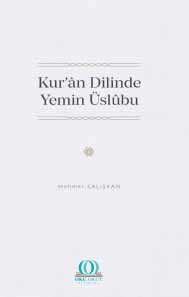Kur’ân Dilinde Yemin Üslûbu
The Style of Oath in the Qur’ānic Language
Author(s): Mehmet ÇALIŞKAN
Subject(s): Language studies, Theology and Religion, Islam studies
Published by: Oku Okut Yayınları
Keywords: Tafsīr; Qur’ān; Qasam; Hilf; Style; Age of ignorance (Jahiliyyah); Mekkī; Madanī;
Summary/Abstract: In this study, in particular, the subject of what qasams mean in the integrity of the Qur’ān is discussed in the context of the Surah.In the introduction of the fourpart study, the subject was examined in terms of scope and method. The first chapter focused on the sameness and difference of concepts such as qasam, oath and hilf within the conceptual framework. In the linguistic framework, the letters used for Qasam are explained; the oath with him (muqsamūn bih) and the answer to the oath (muqsamūn alayh). Again, in the first chapter “zahir” and “muzmar” were explained from the types of vows.
In the second part of the study, the Qasam tradition in Arabic language and culture in the pre-Islamic period was examined. Among the subjects of the oath in ignorance are Allah, the Kaaba, idols, time and many natural beings. In the pre-Islamic period, poets, wizards, oracles, along with expressions of vows to obtain material benefits, said mysterious words that made people believe and turn to themselves. In particular, oracles left their oaths in mystery because they expressed what was sworn with them according to their beliefs and cultures but did not say the answer.
In the third chapter, the forms of qasam in the Mekkī-Madanī Mekkī and Madanī surahs were compared, and in this context, it was found that the qasams in the Mekkī surahs are an example of open vows in general. In this chapter, it is also stated that Allah swears by his person and adjectives, as well as by oath to both observant and exchange beings. In this context, it has also been determined that the qasams in Madanī surahs constitute an example of closed oaths. It is certain that the oaths constitute an introduction to the answer to the oath, as well as noting that the matters that are sworn with it are important for people. Because vows are only completed and understood by their answers. An unanswered oath turns into an action that is unclear why it was sworn. In the third chapter, there are also related examples of those who are sworn in the Qur’ān in the style of “qath and those who constitute answers to the oath. In addition, examples of vows in Qur’ānic stories are also discussed in this section.
In the fourth chapter the possible causes, goals, consequences of the bowl, and the oath of Allah were thinned, and in this chapter, the fiqh dimension of the bowl was also pointed out. Those who believe that Allah Most High will not swear by beings have suggested that this cannot be considered for Allah, since the oath aims to glorify only those who are sworn. Allah's oath to beings is to draw attention to the benefit and harm of the beings who are sworn. In addition, it means that Allah swears to different beings and swears to him over those beings. Because those who say that there is the word “Rab” at the beginning of the objects swore understood the oath to fig as “by the Rab of Tin”.
As a result, it was concluded that the oath was a means of linguistic communication and interaction to inculcate trust and trust between people and societies from the beginning of its history. In the period of ignorance, people swore an oath to anything they considered sacred, while in the Islamic period it was requested that the oath be made only to Allah. During the Islamic period, provisions on oaths were made, they were asked not to swear unless necessary, and Muslims were not welcome to swear unnecessarily. In this context, a false oath was considered a great sin.
- Print-ISBN-13: 978-605-74416-5-2
- Page Count: 181
- Publication Year: 2021
- Language: Turkish
- Table of Content
- eBook-PDF
- Introduction

